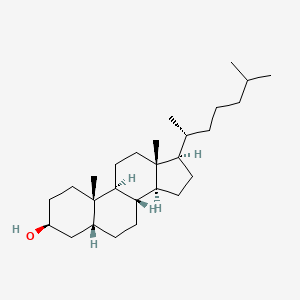| MeSH term | MeSH ID | Detail |
|---|---|---|
| Hypercholesterolemia | D006937 | 91 associated lipids |
| Diabetes Mellitus | D003920 | 90 associated lipids |
| Diabetes Mellitus, Type 2 | D003924 | 87 associated lipids |
| Cataract | D002386 | 34 associated lipids |
| Alcoholism | D000437 | 27 associated lipids |
| Xanthomatosis | D014973 | 17 associated lipids |
| Xanthomatosis, Cerebrotendinous | D019294 | 14 associated lipids |
| Biliary Fistula | D001658 | 13 associated lipids |
| Brain Diseases, Metabolic | D001928 | 9 associated lipids |
Coprosterol
Coprosterol is a lipid of Sterol Lipids (ST) class. Coprosterol is associated with abnormalities such as Cerebrovascular accident, Glycogen Storage Disease Type IV, Coronary Arteriosclerosis, CARDIAC EVENT and Diabetes Mellitus, Non-Insulin-Dependent. The involved functions are known as cholesterol absorption, Death, Sudden, Cardiac, Drug Interactions, Cholesterol Homeostasis and Synthesis. Coprosterol often locates in lipid raft, Tissue membrane, Membrane, Blood and Body tissue. The associated genes with Coprosterol are ABO gene, STN gene, Alleles, Apolipoprotein E gene and TNF gene. The related lipids are saturated fat, campesterol, lathosterol, Sterols and Total cholesterol. The related experimental models are Rodent Model.
Cross Reference
Introduction
To understand associated biological information of Coprosterol, we collected biological information of abnormalities, associated pathways, cellular/molecular locations, biological functions, related genes/proteins, lipids and common seen animal/experimental models with organized paragraphs from literatures.
What diseases are associated with Coprosterol?
Coprosterol is suspected in Coronary Arteriosclerosis, Cerebrovascular accident, Glycogen Storage Disease Type IV, CARDIAC EVENT, Diabetes Mellitus, Non-Insulin-Dependent, Niemann-Pick Diseases and other diseases in descending order of the highest number of associated sentences.
Related references are mostly published in these journals:
| Disease | Cross reference | Weighted score | Related literature |
|---|
Possible diseases from mapped MeSH terms on references
We collected disease MeSH terms mapped to the references associated with Coprosterol
PubChem Associated disorders and diseases
What pathways are associated with Coprosterol
There are no associated biomedical information in the current reference collection.
PubChem Biomolecular Interactions and Pathways
Link to PubChem Biomolecular Interactions and PathwaysWhat cellular locations are associated with Coprosterol?
Visualization in cellular structure
Associated locations are in red color. Not associated locations are in black.
Related references are published most in these journals:
| Location | Cross reference | Weighted score | Related literatures |
|---|
What functions are associated with Coprosterol?
Related references are published most in these journals:
| Function | Cross reference | Weighted score | Related literatures |
|---|
What lipids are associated with Coprosterol?
Related references are published most in these journals:
| Lipid concept | Cross reference | Weighted score | Related literatures |
|---|
What genes are associated with Coprosterol?
Related references are published most in these journals:
| Gene | Cross reference | Weighted score | Related literatures |
|---|
What common seen animal models are associated with Coprosterol?
Rodent Model
Rodent Model are used in the study 'Formation of 7-dehydrocholesterol-containing membrane rafts in vitro and in vivo, with relevance to the Smith-Lemli-Opitz syndrome.' (Keller RK et al., 2004).
Related references are published most in these journals:
| Model | Cross reference | Weighted score | Related literatures |
|---|
NCBI Entrez Crosslinks
All references with Coprosterol
Download all related citations| Authors | Title | Published | Journal | PubMed Link |
|---|---|---|---|---|
| Rosenfeld RS | Analysis of sterol extracts for cholestanol. | 1965 | Anal. Biochem. | pmid:5323673 |
| Schubert K and Kaufmann G | [Formation of sterol esters in bacterial cells]. | 1965 | Biochim. Biophys. Acta | pmid:5326537 |
| Lüscher IF et al. | The introduction of one or two 3 beta-cholestanyl residues into benzylpenicilloyl-eicosa-L-lysines greatly potentiates their tolerogenicity for anti-benzylpenicillol IgE antibody formation. | 1984 | Eur. J. Immunol. | pmid:6229410 |
| Ullrich IH et al. | Alterations of fecal steroid composition induced by changes in dietary fiber consumption. | 1981 | Am. J. Clin. Nutr. | pmid:6270998 |
| Sekimoto H et al. | Interrelationship between serum and fecal sterols. | 1983 | Jpn. J. Med. | pmid:6302358 |
| Andersson S et al. | 25-hydroxylation of C27-steroids and vitamin D3 by a constitutive cytochrome P-450 from rat liver microsomes. | 1983 | J. Biol. Chem. | pmid:6304056 |
| Watabe T et al. | Mouse liver microsomal cholesterol epoxide hydrolase: a specific inhibition of its activity by 5,6 alpha-Imino-5 alpha-cholestan-3 alpha-OL. | 1983 Apr-May | Chem. Biol. Interact. | pmid:6406079 |
| Kaibara N et al. | Fecal bile acids and neutral sterols in Japanese with large bowel carcinoma. | 1983 | Oncology | pmid:6408548 |
| Canelas HM et al. | Cerebrotendinous xanthomatosis: clinical and laboratory study of 2 cases. | 1983 | Acta Neurol. Scand. | pmid:6410671 |
| Björkhem I et al. | Isolation of 5 alpha-cholestane-3 beta, 7 alpha-diol from bile of patients with cerebrotendinous xanthomatosis. Inefficiency of this steroid as a precursor to cholestanol. | 1983 | Biochim. Biophys. Acta | pmid:6412759 |
